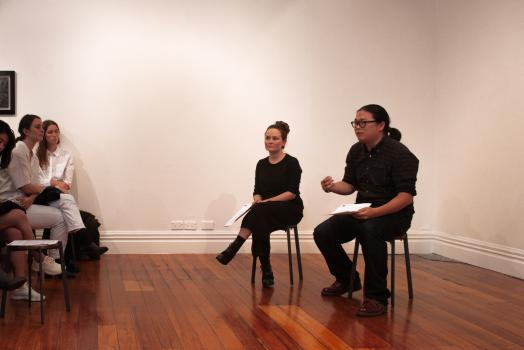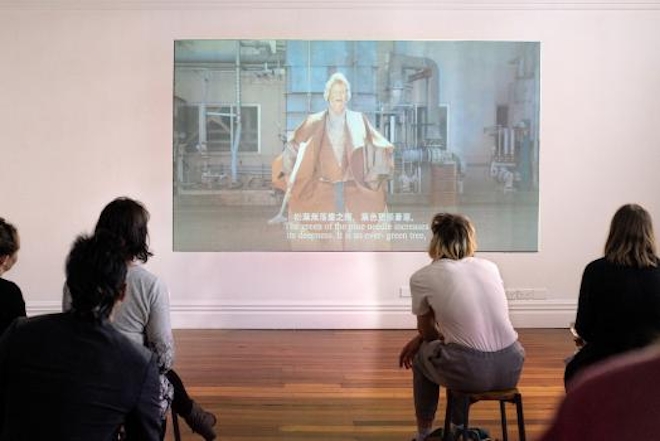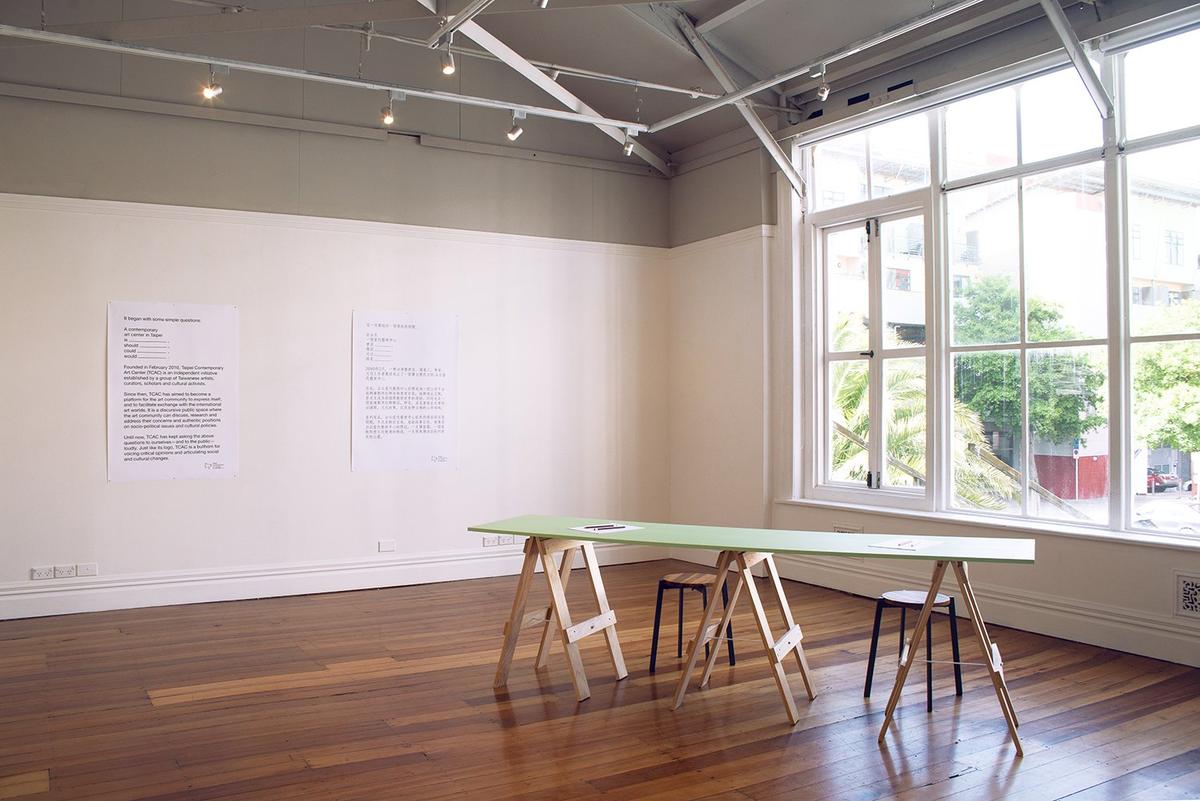As part of an exchange with Enjoy Gallery in Wellington from 8 November-8 December 2018, Taipei Contemporary Art Center present It Follows, a two part installation which seeks to unpack some of the social, political and artistic ambitions of contemporary art spaces. In Part 1 Enjoy’s audience were invited to anonymously answer a series of open-ended questions, in Part II, TCAC presented five recent video works from Taipei. CIRCUIT Director Mark Williams sat down with visiting TCAC curator Bochun Hsiao, TCAC board member Frankie Su, and Enjoy Director Sophie Davis to discuss the role of contemporary spaces like Enjoy and TCAC in an ever-changing landscape of institutional and artistic flux.
Mark Williams: How did you all come to meet?
Sophie Davis: I first visited TCAC in October 2017 as part of the Asia New Zealand Foundation Curators Tour. I had a brief chat with their former director Esther Lu, who told me that TCAC were very interested in alternative or experimental practices. Also in foregrounding the labour conditions of contemporary art practice and curatorial labour itself. I got back in touch with TCAC maybe about six months later to see whether they were interested in striking up a conversation. I ended up talking to Bochun and Frankie Su, who has curated the screening program. We started talking about some kind of exchange.
Mark Williams: Bochun, could you tell us about the TCAC, when it was set up, who it was set up by and for what purpose?
Bochun Hsiao: TCAC was founded in 2010 by a group of artists, curators, and even some designers and casual workers. At first, they tried to fund the foundation only by this group of people. We thought it might give us more freedom to do what we like, instead of being controlled or under observation by (the) government. After eight years, we are changing a little bit. We get some funding from government. That gives us more ability to program abroad.
Mark Williams: Frankie, could you tell us about the TCAC program?
Frankie Su: From the start, we asked ourselves, ‘what can TCAC do that other institutions cannot do or support? So first of all we started doing international programs with international curators or artists. We've done quite a lot of exchange programs with Japan, with Korea, with China, even with some European countries. But then a few years later, we also felt like we also needed to have our curatorial point of view. We started to plan exhibitions. But more experimental exhibitions which try to discuss issues that are not discussed in Taiwan or especially Taipei.
Mark Williams: What kind of issues?
Frankie Su: We do lots of different programs, we are also involved with some of the festivals that do transgender issues or gay marriage issues and things like that. In Taiwan (this) is not the topic that you want to touch or you want to talk about.
Bochun Hsiao: I think we were the first private institution who started to do regular programs (of) interesting or experimental artist videos.
Frankie Su: In Taipei now, most of the resources are controlled by the big institutions, which are mostly funded by the government, which means you don't have alternative voices. Of course there are a lot of other small spaces or alternative spaces. But TCAC is very different in that …we actually spend a lot of time trying to gather group opinions instead of just one person's opinions.
Mark Williams: So the need of the community was to see work that was politically sensitive or controversial, but also you felt that there was a need to spread Taiwanese work more into the world as well?
Bochun Hsiao: Yeah.
Frankie Su: To start with, it was actually not the most popular topic. But we're getting better in these (past) two years. We are having a lot of younger audiences.

It follows (Part 2: Programmes), presented by Taipei Contemporary Art Center, preview screening and Q & A with Bochun Hsiao, 28 November 2018. Image courtesy of Xander Dixon
Mark Williams: Sophie, I remember when Enjoy was set up by some ex-students, some 20 years ago. Since then it's evolved into more of a institutional model. How do you think Enjoy operates in the Wellington community now?
Sophie Davis: There are some parallels with TCAC (in that) Enjoy fills a gap in the ecosystem. We are operating in a way that is different, to say, an artist run space or to a larger institution in that we're a small dedicated team. There's a lot of curatorial support, logistical support. Each project is developed with a lot of consideration. Also thinking about our audiences in a similar way to what Bochun and Frankie have just said. I think it's really important that we’re challenging our audience while reflecting their urgent needs and concerns. We're not necessarily pandering to what they might expect, but we're pushing forward conversations. I guess in Wellington, that looks like all sorts of different things. It includes bringing in new voices and people that are not from Wellington, not from Aotearoa. It's wonderful to have TCAC here because it opens up different kinds of conversation (and) builds dialogue between the art scene here in Wellington and further afield.
Mark Williams: Let’s talk about the questions asked in the first part of the show. "A contemporary art space in Te Whanganui-a-Tara Wellington is / should / could / would... Why raise these questions now?
Bochun Hsiao: This question was originally from an artist called Yung Chun. He's Australian but Taiwanese. In 2009, (for) the Taipei biennial, he posed the question, and the audience (were invited to) answer the question. Back then, there weren't many art spaces or alternative spaces in Taipei, Taiwan, only big museums. A group of artists and curators, 30 people, gathered for a weekend discussion of these issues. The answer was "We should have a place called Taipei Contemporary Art Center." I brought this question to Wellington, because those answers ask the audience and others here (about) how they feel, what they need or what they lack.
Mark Williams: Sophie, tell us how the responses have been? People could answer could answer online or in the gallery, was that right?
Sophie Davis: When people walked into the gallery space, there was a table set up with the questionnaire. So visitors could fill it in in the gallery, or they could fill it in online. It was anonymous, so you didn't have to put your name on it. Some people just said "A contemporary art space should show my work." Or "A contemporary art space should be open." But then we also got some really interesting responses, like "A contemporary art space should be more than a gallery space. A contemporary art space should remunerate artists well and always be striving to do better. A contemporary art space should take risks."
All of those things are really important for Enjoy to think about. We've been established for 18 years now. There's been shifts in the landscape here in Wellington with new artist run spaces popping up and things like that, that mean we definitely should be thinking about the question of what we do that other spaces and institutions can't, won't or just don't want to do, or the conversations that we can push further.
Mark Williams: What's the most surprising answer that you received, or the one that struck you as enlightening or most provocative or interesting?
Sophie Davis: I think the idea of being more than a gallery space. TCAC is not very exhibition based, it's more fluid than that. So that was interesting for me to think about. But I also need to read through all of the responses, because I just arrived back in New Zealand the other day.
Mark Williams: I think one thing about Enjoy – as opposed to the artist run spaces in Wellington you mention – is that, you're sitting right now in front of a whole lot of publications, so there's a sense of historical memory...
Sophie Davis: Definitely.
Mark Williams: ... and that's embodied in Enjoy in away that it isn't necessarily at artist run spaces, which can often can be quite fragile.
Sophie Davis: Institutional memory and the archive is something that I'm really interested in. I think that we could do more to make it more accessible to people. Particularly because spaces like Enjoy, Blue Oyster, the Physics Room and RM started out as artist-run initiatives. That means that they have, I think, a unique function in art history stretching back close to 20 years now.
Mark Williams: What about at TCAC? You're coming up to 10 years. Is it necessary to be the holders of that history? Or is it more that you've got limited resources and you should put them all into supporting contemporary art now? Or both?
Frankie Su: We're planning to do a publication looking back at those 10 years. The most important thing of course (is to) ask ourselves continuously what contemporary art should be or is. It's not that we have to exist for the reason (of) existing. It's more like if we are still-
Bochun Hsiao: Being needed.
Frankie Su: Being needed in Taiwan, in art, then we will be there.
Bochun Hsiao: An important mission of TCAC is trying to reflect current social issues. We have to take action very quickly to respond to what is happening now. But we need to know our position or our rule. It depends on the audience, their ideas. It's very important that we look back to see how we act and know how the audience reacted to us.
Mark Williams: In terms of the works in the show at Enjoy, what do you think they say about contemporary Taiwanese art right now? Or the circumstances under which Taiwanese art is made?
Frankie Su: That's also a big question.
Bochun Hsiao: That's a big question. (laughter)
Before we come in (to Wellington), we were discussing ‘do we bring work focusing on the issues happening in Taiwan?’. There are a lot of Taiwanese artists focussed on global issues like the environment. But we (decided) that we have to show what is happening in the island. Maybe people in Wellington don't know where Taiwan is, or they've never been there before. We (decided) to show a little bit of history and what the artists are discussing. Also the conversation between young and old generations. So (the show at Enjoy) is more about historical identities in Taiwan instead of global issues.

It follows (Part 2: Programmes), presented by Taipei Contemporary Art Center, preview screening and Q & A with Bochun Hsiao, 28 November 2018. Image courtesy of Xander Dixon
